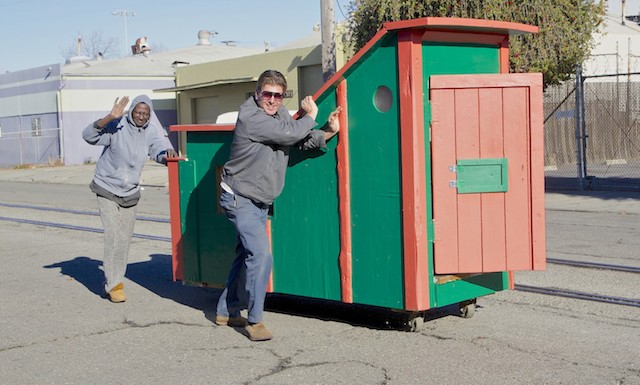By Daphne Auza
Being homeless means finding ways to survive without basic necessities. Forced to navigate their daily lives in public spaces, the homeless are subject to all kinds of dangers, especially the elements. Although there are shelters that provide temporary stays for those in need, they cannot protect every person on the street from harsh rains, snow, cold and bitter winds.
Oakland artist Gregory Kloehn chose to utilize his creativity to remedy the problem. Inspired by the small home environmental movement, he began to construct mobile homes using illegally discarded garbage. The charming, environmentally friendly structures recall the miniature homes of the tiny house movement, which aims for sustainable living on a small scale.
Kloehn’s particular project hopes to serve the immediate needs of the homeless. In the past year, he has already constructed ten homes. Each comes with a pitched roof and wheels so that their owners can transport them easily across town. According to an interview with CNN, Kloehn’s aesthetically pleasing designs have received mostly rave reviews from his homeless clients.
Each of the small shelters takes about two to three days to make. Kloehn drew inspiration from his observations of homeless persons who recycled everything they found on the street in order to make a living. He used his own knowledge and skill to create durable designs; the components of which include pizza delivery bag insulation and foundations of wooden pallets.
The artist’s work has inspired others to participate in advocacy for the homeless. Volunteers have stepped forward to help, and as word of his project grows, so does the amount of supporters. On his Facebook page, he invites the Oakland community to assist with building, and some of them have gone so far as to provide materials and workspace.
Gregory Kloehn is not the only one pursuing these architectural innovations for people in need. Timothy Payne, CEO of Forest YMCA in London, now dedicates his life to creative solutions for temporarily housing the homeless. Payne was disappointed in the costly accommodations that prevented graduates of his supported housing program from finding new homes and living independently. He then decided to take matters into his own hands by launching mYPad.

mYpads imports shipping containers from China and converts them into studio apartments. They are available at an affordable price, at least in comparison to the average flat in London. In addition, each shipping container home is fitted with a shower, toilet, sink, bed, fridge, microwave, TV, clothing storage and heating. They mean to serve as an option for needy people at a transitional point in their lives, those who are saving up for a deposit for their new homes.
On another part of the continent, Danish designer Ragnhild Lubbert Tipling was developing her own approach to homeless people’s problems of shelter, mobility and storage. Inspired by a lecture on the problems facing homeless communities, she decided that she would create a product both by and for homeless people. Tipling spent weeks at a homeless shelter interviewing individuals about their needs and inviting their feedback for different plans and drafts.
The end product is the Urban Rough Sleeper, a tough, waterproof tent that rolls up into a backpack and has extra storage for belongings. Tipling is currently working on two prototypes that will be manufactured and hopefully sold to camping outfitter companies in the near future. Proceeds from sales will go towards donating the product to the homeless.
On a policy level, these unconventional homeless shelters do not offer a resolution for homelessness in Western societies. What they do provide is temporary protection and relief from the harsh outdoor conditions that people living on the streets deal with day to day. Until the larger problems at hand are fixed, however, Kloehn, Payne and Terpling’s efforts continue to be welcomed by those in need.
ABOUT THE WRITER
Based in Los Angeles, Daphne Auza is a current student at Occidental College pursuing a major in English and Comparative Literary Studies. Her interests lie in travel, poems, and the intersection between the arts and social justice, but her curiosity extends far beyond those realms as well. She likes to think that many of her passions are founded on her seemingly insatiable restlessness. You can check out her daily musings and other writings at candidkandu.tumblr.com.




